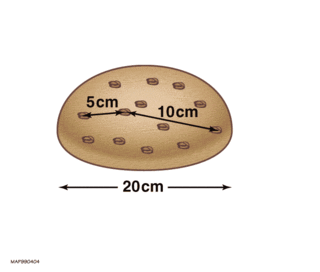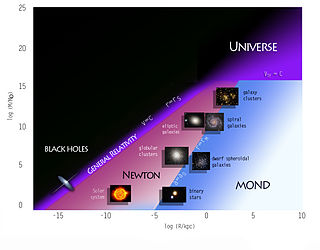In astronomy, dark matter is a hypothetical form of matter that appears not to interact with light or the electromagnetic field. Dark matter is implied by gravitational effects which cannot be explained by general relativity unless more matter is present than can be seen. Such effects occur in the context of formation and evolution of galaxies, gravitational lensing, the observable universe's current structure, mass position in galactic collisions, the motion of galaxies within galaxy clusters, and cosmic microwave background anisotropies.

Galaxy groups and clusters are the largest known gravitationally bound objects to have arisen thus far in the process of cosmic structure formation. They form the densest part of the large-scale structure of the Universe. In models for the gravitational formation of structure with cold dark matter, the smallest structures collapse first and eventually build the largest structures, clusters of galaxies. Clusters are then formed relatively recently between 10 billion years ago and now. Groups and clusters may contain ten to thousands of individual galaxies. The clusters themselves are often associated with larger, non-gravitationally bound, groups called superclusters.

In physics, a redshift is an increase in the wavelength, and corresponding decrease in the frequency and photon energy, of electromagnetic radiation. The opposite change, a decrease in wavelength and simultaneous increase in frequency and energy, is known as a blueshift, or negative redshift. The terms derive from the colours red and blue which form the extremes of the visible light spectrum. The main causes of electromagnetic redshift in astronomy and cosmology are the relative motions of radiation sources, which give rise to the relativistic Doppler effect, and gravitational potentials, which gravitationally redshift escaping radiation. All sufficiently distant light sources show cosmological redshift corresponding to recession speeds proportional to their distances from Earth, a fact known as Hubble's law that implies the universe is expanding.

Hubble's law, also known as the Hubble–Lemaître law, is the observation in physical cosmology that galaxies are moving away from Earth at speeds proportional to their distance. In other words, the farther they are, the faster they are moving away from Earth. The velocity of the galaxies has been determined by their redshift, a shift of the light they emit toward the red end of the visible spectrum.

A gravitational lens is matter, such as a cluster of galaxies or a point particle, that bends light from a distant source as it travels toward an observer. The amount of gravitational lensing is described by Albert Einstein's general theory of relativity with much greater accuracy than Newtonian physics, which treats light as corpuscles travelling at the speed of light.
In cosmology and physics, cold dark matter (CDM) is a hypothetical type of dark matter. According to the current standard model of cosmology, Lambda-CDM model, approximately 27% of the universe is dark matter and 68% is dark energy, with only a small fraction being the ordinary baryonic matter that composes stars, planets, and living organisms. Cold refers to the fact that the dark matter moves slowly compared to the speed of light, giving it a vanishing equation of state. Dark indicates that it interacts very weakly with ordinary matter and electromagnetic radiation. Proposed candidates for CDM include weakly interacting massive particles, primordial black holes, and axions.
Peculiar motion or peculiar velocity refers to the velocity of an object relative to a rest frame — usually a frame in which the average velocity of some objects is zero.
The Sunyaev–Zeldovich effect is the spectral distortion of the cosmic microwave background (CMB) through inverse Compton scattering by high-energy electrons in galaxy clusters, in which the low-energy CMB photons receive an average energy boost during collision with the high-energy cluster electrons. Observed distortions of the cosmic microwave background spectrum are used to detect the disturbance of density in the universe. Using the Sunyaev–Zeldovich effect, dense clusters of galaxies have been observed.
The Sachs–Wolfe effect, named after Rainer K. Sachs and Arthur M. Wolfe, is a property of the cosmic microwave background radiation (CMB), in which photons from the CMB are gravitationally redshifted, causing the CMB spectrum to appear uneven. This effect is the predominant source of fluctuations in the CMB for angular scales larger than about ten degrees.
The Lambda-CDM, Lambda cold dark matter or ΛCDM model is a mathematical model of the Big Bang theory with three major components:
- a cosmological constant denoted by lambda (Λ) associated with dark energy,
- the postulated cold dark matter, and
- ordinary matter.
Redshift quantization, also referred to as redshift periodicity, redshift discretization, preferred redshifts and redshift-magnitude bands, is the hypothesis that the redshifts of cosmologically distant objects tend to cluster around multiples of some particular value.
The expansion of the universe is the increase in distance between gravitationally unbound parts of the observable universe with time. It is an intrinsic expansion; the universe does not expand "into" anything and does not require space to exist "outside" it. To any observer in the universe, it appears that all but the nearest galaxies recede at speeds that are proportional to their distance from the observer, on average. While objects cannot move faster than light, this limitation only applies with respect to local reference frames and does not limit the recession rates of cosmologically distant objects.
An inhomogeneous cosmology is a physical cosmological theory which, unlike the currently widely accepted cosmological concordance model, assumes that inhomogeneities in the distribution of matter across the universe affect local gravitational forces enough to skew our view of the Universe. When the universe began, matter was distributed homogeneously, but over billions of years, galaxies, clusters of galaxies, and superclusters have coalesced, and must, according to Einstein's theory of general relativity, warp the space-time around them. While the concordance model acknowledges this fact, it assumes that such inhomogeneities are not sufficient to affect large-scale averages of gravity in our observations. When two separate studies claimed in 1998-1999 that high redshift supernovae were further away than our calculations showed they should be, it was suggested that the expansion of the universe is accelerating, and dark energy, a repulsive energy inherent in space, was proposed to explain the acceleration. Dark energy has since become widely accepted, but it remains unexplained. Accordingly, some scientists continue to work on models that might not require dark energy. Inhomogeneous cosmology falls into this class.

While the presence of any mass bends the path of light passing near it, this effect rarely produces the giant arcs and multiple images associated with strong gravitational lensing. Most lines of sight in the universe are thoroughly in the weak lensing regime, in which the deflection is impossible to detect in a single background source. However, even in these cases, the presence of the foreground mass can be detected, by way of a systematic alignment of background sources around the lensing mass. Weak gravitational lensing is thus an intrinsically statistical measurement, but it provides a way to measure the masses of astronomical objects without requiring assumptions about their composition or dynamical state.

Strong gravitational lensing is a gravitational lensing effect that is strong enough to produce multiple images, arcs, or even Einstein rings. Generally, for strong lensing to occur, the projected lens mass density must be greater than the critical density, that is . For point-like background sources, there will be multiple images; for extended background emissions, there can be arcs or rings. Topologically, multiple image production is governed by the odd number theorem.
In physical cosmology and astronomy, dark energy is an unknown form of energy that affects the universe on the largest scales. Its primary effect is to drive the accelerating expansion of the universe. Assuming that the lambda-CDM model of cosmology is correct, dark energy is the dominant component of the universe, contributing 68% of the total energy in the present-day observable universe while dark matter and ordinary (baryonic) matter contribute 26% and 5%, respectively, and other components such as neutrinos and photons are nearly negligible. Dark energy's density is very low: 6×10−10 J/m3, much less than the density of ordinary matter or dark matter within galaxies. However, it dominates the universe's mass–energy content because it is uniform across space.
Modified Newtonian dynamics (MOND) is a hypothesis that proposes a modification of Newton's second law to account for observed properties of galaxies. It is an alternative to the hypothesis of dark matter in terms of explaining why galaxies do not appear to obey the currently understood laws of physics.

Ofer Lahav is Perren Chair of Astronomy at University College London (UCL), Vice-Dean (International) of the UCL Faculty of Mathematical and Physical Sciences (MAPS) and Co-Director of the STFC Centre for Doctoral Training in Data Intensive Science. His research area is Observational Cosmology, in particular probing Dark Matter and Dark Energy. His work involves Machine Learning for Big Data.

Extended theories of gravity are alternative theories of gravity developed from the exact starting points investigated first by Albert Einstein and Hilbert. These are theories describing gravity, which are metric theory, "a linear connection" or related affine theories, or metric-affine gravitation theory. Rather than trying to discover correct calculations for the matter side of the Einstein field equations; which include inflation, dark energy, dark matter, large-scale structure, and possibly quantum gravity; it is proposed, instead, to change the gravitational side of the equation.

Cosmic voids are vast spaces between filaments, which contain very few or no galaxies. The cosmological evolution of the void regions differs drastically from the evolution of the Universe as a whole: there is a long stage when the curvature term dominates, which prevents the formation of galaxy clusters and massive galaxies. Hence, although even the emptiest regions of voids contain more than ~15% of the average matter density of the Universe, the voids look almost empty to an observer.






